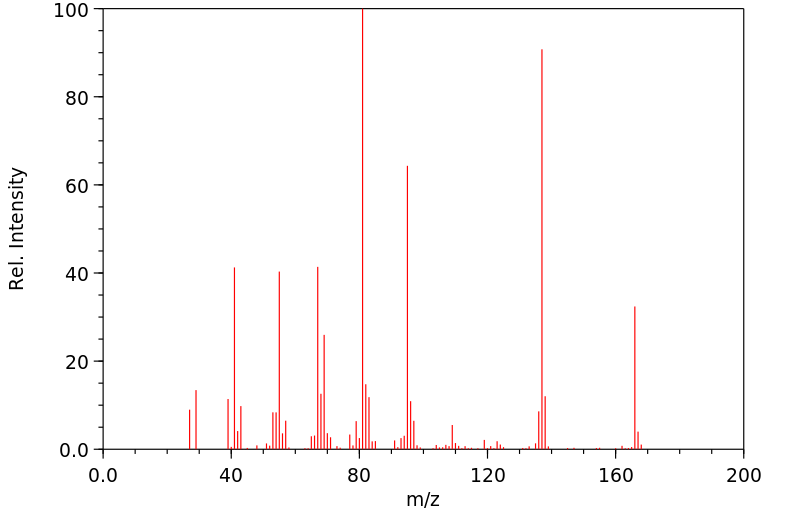β-Ethyl-decalin | 1618-23-1
中文名称
——
中文别名
——
英文名称
β-Ethyl-decalin
英文别名
beta-Ethyldecalin;2-ethyl-1,2,3,4,4a,5,6,7,8,8a-decahydronaphthalene
CAS
1618-23-1
化学式
C12H22
mdl
MFCD06252426
分子量
166.307
InChiKey
HLQZZLGOHWUHQM-UHFFFAOYSA-N
BEILSTEIN
——
EINECS
——
-
物化性质
-
计算性质
-
ADMET
-
安全信息
-
SDS
-
制备方法与用途
-
上下游信息
-
文献信息
-
表征谱图
-
同类化合物
-
相关功能分类
-
相关结构分类
物化性质
-
沸点:221.85°C
-
密度:0.8801
-
保留指数:1258;1290;1239;1252;1247;1259;1275;1284;1278;1288;1258
计算性质
-
辛醇/水分配系数(LogP):5.4
-
重原子数:12
-
可旋转键数:1
-
环数:2.0
-
sp3杂化的碳原子比例:1.0
-
拓扑面积:0
-
氢给体数:0
-
氢受体数:0
SDS
反应信息
-
作为产物:描述:2-萘乙酮 在 rhodium(III) chloride 、 氢气 作用下, 以 2,2,2-三氟乙醇 为溶剂, 100.0 ℃ 、5.0 MPa 条件下, 反应 10.0h, 以91%的产率得到β-Ethyl-decalin参考文献:名称:溶剂决定了使用未连接的 RhCl3 作为催化剂前体的芳香酮加氢产物摘要:烷基环己烷被以高选择性合成通过使用无配体的RhCl芳族酮的组合加氢/加氢脱氧3如三氟乙醇作为溶剂的预催化剂。真正的催化剂由反应过程中原位生成的铑纳米颗粒 (Rh NPs) 组成。在相对温和的条件下,一系列共轭和非共轭芳族酮被直接加氢脱氧成相应的饱和环己烷衍生物。发现溶剂是改变酮氢化选择性的决定因素。环己基烷基醇是以水为溶剂的产物。DOI:10.1039/d1cy01504d
文献信息
-
Bimetallic Nanoparticles in Supported Ionic Liquid Phases as Multifunctional Catalysts for the Selective Hydrodeoxygenation of Aromatic Substrates作者:Lisa Offner-Marko、Alexis Bordet、Gilles Moos、Simon Tricard、Simon Rengshausen、Bruno Chaudret、Kylie L. Luska、Walter LeitnerDOI:10.1002/anie.201806638日期:2018.9.24Bimetallic iron–ruthenium nanoparticles embedded in an acidic supported ionic liquid phase (FeRu@SILP+IL‐SO3H) act as multifunctional catalysts for the selective hydrodeoxygenation of carbonyl groups in aromatic substrates. The catalyst material is assembled systematically from molecular components to combine the acid and metal sites that allow hydrogenolysis of the C=O bonds without hydrogenation
-
Selective Hydrogenation and Hydrodeoxygenation of Aromatic Ketones to Cyclohexane Derivatives Using a Rh@SILP Catalyst作者:Gilles Moos、Meike Emondts、Alexis Bordet、Walter LeitnerDOI:10.1002/anie.201916385日期:2020.7.13sed supported ionic liquid phase (Rh@SILP(Ph3‐P‐NTf2)) enabled the selective hydrogenation and hydrodeoxygenation of aromatic ketones. The flexible molecular approach used to assemble the individual catalyst components (SiO2, ionic liquid, nanoparticles) led to outstanding catalytic properties. In particular, intimate contact between the nanoparticles and the phosphonium ionic liquid is required for固定在无酸三苯基phosph基支持的离子液相(Rh @ SILP(Ph 3 -P-NTf 2))上的铑纳米颗粒能够选择性氢化和芳族酮加氢脱氧。用于组装各个催化剂组分(SiO 2,离子液体,纳米颗粒)的灵活分子方法导致了出色的催化性能。特别地,纳米颗粒与phospho离子液体之间的紧密接触对于脱氧反应性是必需的。Rh @ SILP(Ph 3 -PNTf 2)催化剂在温和条件下对苄基酮的加氢脱氧具有活性,并且通过调节反应温度以高选择性控制氢化(醇)和加氢脱氧(烷烃)之间非苄基酮的产物分布。多功能的Rh @ SILP(Ph 3 -P-NTf 2)催化剂为Friedel-Crafts酰化产物和木质素衍生的芳族酮的加氢和/或加氢脱氧开辟了生产各种高价值环己烷衍生物的途径。 。
-
Chemoselective and Tandem Reduction of Arenes Using a Metal–Organic Framework-Supported Single-Site Cobalt Catalyst作者:Neha Antil、Ajay Kumar、Naved Akhtar、Wahida Begum、Manav Chauhan、Rajashree Newar、Manhar Singh Rawat、Kuntal MannaDOI:10.1021/acs.inorgchem.1c03098日期:2022.1.17five times without decreased activity. The same MOF-Co catalyst was also efficient for tandem hydrogenation–hydrodeoxygenation of aryl carbonyl compounds, including biomass-derived platform molecules such as furfural and hydroxymethylfurfural to cycloalkanes. In the case of hydrogenation of cumene, our spectroscopic, kinetic, and density functional theory (DFT) studies suggest the insertion of a trisubstituted使用丰富的金属开发多相、化学选择性和串联催化系统对于精细和大宗化学品的可持续合成至关重要。我们报告了一种基于多孔铝金属有机骨架 (DUT-5 MOF) 的稳健且可回收的单中心钴氢化物催化剂,用于芳烃的化学选择性加氢。DUT-5 节点负载的氢化钴 (II) (DUT-5-CoH) 是一种多功能固体催化剂,用于化学选择性氢化一系列非极性和极性芳烃,包括杂芳烃,如吡啶、喹啉、异喹啉、吲哚和呋喃以优异的收率提供环烷烃和饱和杂环。DUT-5-CoH 表现出优异的官能团耐受性,可重复使用至少五次而不会降低活性。相同的 MOF-Co 催化剂也可有效用于芳基羰基化合物的串联加氢-加氢脱氧,包括生物质衍生的平台分子(如糠醛和羟甲基糠醛)生成环烷烃。在异丙苯加氢的情况下,我们的光谱、动力学和密度泛函理论 (DFT) 研究表明,在转换限制步骤中将三取代烯烃中间体插入到 Co-H 键中。我们的工作突出了 MOF
-
THE SYNTHESIS OF SOME STEREOISOMERIC DERIVATIVES OF DECAHYDRONAPHTHALENE作者:A. Zlatkis、E. A. SmithDOI:10.1139/v51-020日期:1951.2.1reaction between these chlorodecalins and ethylmagnesium bromide has been studied and two racemates of trans 2-ethyl decalin have been isolated. Some progress has been made in the preparation of the 9-chlorodecalins. A new method for converting cis decalin to trans decalin rapidly in high yield using tertiary butyl chloride and anhydrous aluminum chloride is indicated.
-
——作者:I. S. Akhrem、I. M. Churilova、S. V. VittDOI:10.1023/a:1009529302679日期:——Cyclohexane and methylcyclopentane dimerize into dimethyldecalins on treatment with superelectrophilic systems containing polyhalomethanes (CBr4, CCl4, CHCl3) and aluminum halides (AlBr3, AlCl3). At 20 degreesC, the yields Of C12H22 hydrocarbons reach 140 mol.% based on the superelectrophile. Under the action of CBr4. 2AlBr(3) at 20 degreesC in CH2Br2 or without a solvent, n-pentane is converted predominantly into lower alkanes (mainly, isopentane). In addition, higher branched C-8-C-12 alkanes, small amounts of alkylated cyclohexanes, cycloalkenes, dienes, and alkylbenzenes are formed in a total yield of 20-23% (w/w) based on pentane.
表征谱图
-
氢谱1HNMR
-
质谱MS
-
碳谱13CNMR
-
红外IR
-
拉曼Raman
-
峰位数据
-
峰位匹配
-
表征信息
同类化合物
降冰片烯
金刚烷-D16
金刚烷
螺戊烷
螺二環己烷
螺[5.6]十二烷
螺[5.5]十一碳-4-烯
螺[5.2]辛-2-烯
螺[4.5]癸烷
螺[4.4]壬-8-烯
螺[3.4]辛烷
螺[3.4]辛-7-烯
螺[3.3]庚-2,5-二烯
螺[2.5]辛烷
螺[2.5]辛-7-烯
螺[2.5]辛-5,7-二烯
螺[2.4]庚-4,6-二烯
螺[2.4]庚-1-烯
螺[2.3]己-1-烯
螺[2.2]戊-1-烯
螺<二环<2.2.2>辛-5-烯-2,1'-环丙烷>
螺<4.4>壬-1,3,7-三烯
螺<4.4>壬-1,3,6,8-四烯
螺(4.4)壬烷
螺(4.4)壬-1,3-二烯
螺(3.4)辛-5,7-二烯
trans-perhydroazulene
萘烷
萘,1,2,3,4,4a,8a-六氢-,顺-
美罗培南中间体F9
篮烷
立方烷
氨基甲硫酸,二甲基-,O,O-(3,3-二甲基1,1-联苯基-2,2-二基)酯
棱晶烷
杜瓦苯
新戊基-1金刚烷
抗氧化剂TH-CPL
庚搭烯
四螺[2.0.2:0.2:0.2:0]十二烷
四螺[2.0.0.0.2.1.1.1]十一烷,顺-
四环己基铅
四环[5.3.0.0<2,6>.0<3,10>]癸-4,8-二烯
四环[5.3.0.0(2,6).0(3,10)]癸烷
四环[4.4.0.02,10.03,7]癸-4,8-二烯
四环[4.2.2.26,5.01,6]十二烷
四环[4.2.0.02,5.03,8]辛烷
四环[3.3.0.02,4.03,6]辛-7-烯
四环<5.3.1.02,6.04,9>十一烷
四环(8.2.2.22,5.26,9)十八碳-1,5,9-三烯
四环(4.1.0.0(2,4).0(3,5))庚烷







